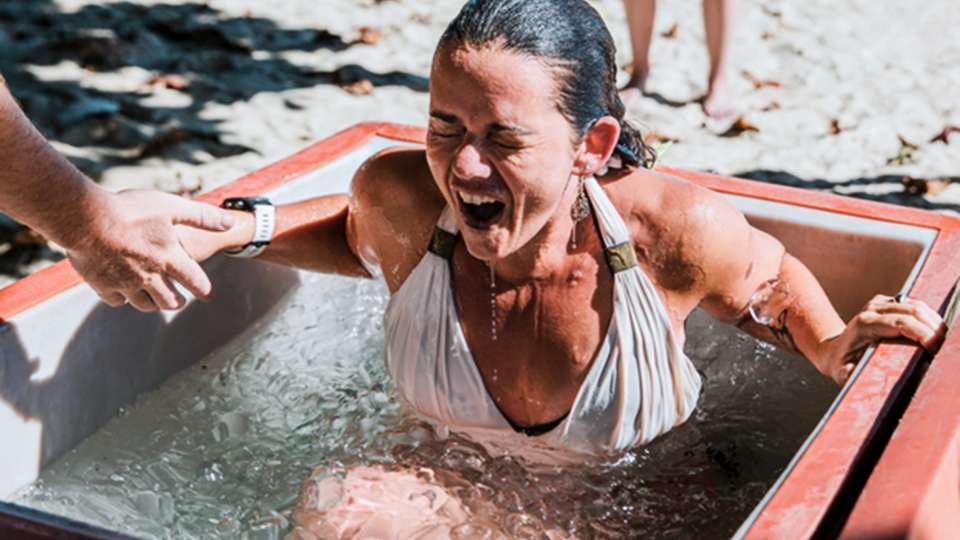
It seems like more and more people these days are talking about the benefits of a cold plunge. Maybe you’ve seen one of those fancy outdoor cold-plunge tubs that athletes fill with ice and hop into, or you have a friend who loves to do a weekly dunk in Puget Sound. Evangelists claim it heals everything from stress and anxiety to inflammation and injuries.
But is there any science behind these claims? And do the benefits of submerging your body in ice-cold water outweigh the risks (like, you know, hypothermia)?
What do people claim are the health benefits of a cold plunge?
People sharing their cold plunge experiences make a lot of claims about it: It makes you more alert, it helps you lose weight, it helps you sleep better, it eases stress, it boosts the immune system.
Similar claims are made about whole-body cryotherapy booths or chambers, where a person steps into the machine and stays in temps as cold as minus 200 degrees for a few minutes.
Many of these claims don’t have much research to back them up, says Nika Cortese, a physical therapist who works at the Sports Medicine Center at Husky Stadium.
It’s important to note that there is also no proof that spending a lot of money on specialized equipment like tubs and pods will provide more health benefits. Basically, immersing most of your body into water that’s cold enough to make you shiver classifies as a cold plunge, whether that’s jumping into a semi-frozen lake or something as simple as taking a cold bath or shower, which is accessible for most people.
And there are some tried-and-true-benefits to subjecting yourself to the cold.
Cold plunge and pain relief
Immersion in cold water has been well-studied in athletes and shown to reduce physical pain, says Dr. Christopher McMullen, a UW Medicine physical medicine and rehabilitation doctor who also specializes in sports medicine.
Doctors and physical therapists use other types of cold therapy to address inflammation and pain, too:
- Ice packs applied to swollen or painful areas
- Ice cupping, which involves filling small cups with water and rubbing them over the body
- Cold compression sleeves wrapped around the legs or arms
“Cold therapy is very different from a cold plunge in terms of the purpose of it,” Cortese says. “We’re looking to reduce inflammation or swelling in someone who’s in an acute phase of injury.”
A little inflammation is necessary for the healing process, Cortese notes, but too much can actually inhibit recovery and impair function — hence why cold therapy is important.
After the swelling is reduced, people can continue to use cold therapy for pain relief.
Cold plunge and mental health
So what about mental pain?
Though many people say cold plunging helps reduce anxiety and stress, cold water immersion actually puts a lot of stress on the body.
To keep vital organs like your heart and lungs warm, your blood vessels constrict, diverting blood flow to your core and away from your extremities. Because of this, your heart rate and blood pressure will increase.
“Cold immersion has been shown in studies to cause release of adrenaline, cortisol, endorphins and dopamine,” McMullen says.
Adrenaline and cortisol could contribute to feelings of mental stress, but endorphins and dopamine are both neurotransmitters in the brain that help you feel a sense of pleasure. If you’re able to move past the initial shock of the cold water and feel accomplished after getting through the temporary discomfort, that could further contribute to stress relief.
One reason people may try a cold plunge is to attempt to trigger the parasympathetic, or “rest and digest,” part of their nervous system, which promotes feelings of calm, says Cortese. This doesn’t happen right away — in fact, an initial cold plunge actually triggers your sympathetic nervous system or “fight or flight” response. But the theory is that repeated exposure will train your body to react less strongly to the sudden cold.
However, cold plunging is not a substitute for something like therapy or medication if you’re dealing with more significant mental health issues.
Cold plunge and the immune system
It’s not yet known if cold plunging can keep you from getting sick or help with autoimmune diseases or other conditions that affect the immune system.
But it’s possible cold plunging could boost immune system health in general.
“Repeated cold water immersion has been shown to increase the circulating concentration of certain immune system cells and proteins,” McMullen says.
When your blood vessels constrict due to the cold temperature, this could also limit the activity of neutrophils, the white blood cells that are your immune system’s first line of defense against invaders. Repeated exposure to cold in this way is theorized to help prime the body to fight infection, which could help with your immune system’s overall health, but doctors still need to do more research.
“Whether these increases actually lead to a reduction in illness frequency has yet to be seen,” says McMullen.
How to do a cold plunge safely
“If cold water immersion is something you’re looking to get into, like with most things, start modestly,” McMullen says. “Begin in a controlled environment for a short period of time and work your way up from there rather than, say, jumping in the frozen lake.”
He recommends starting with two, five-minute plunges into water that is around 50 degrees Fahrenheit (so, maybe a cold bath at home). Between each plunge, take a break in room temperature air for a couple of minutes.
“If you start to shiver during the plunge, that's what's supposed to happen, and shivering may enhance that physiological response that leads to endorphin production and stimulating the immune system,” he explains.
Why not start out in colder water, you might wonder? Jumping into a frigid lake — or any body of water that’s below 50 degrees Fahrenheit — can cause cold water shock, which can also increase the risk of drowning. Staying in extreme cold for longer than a few minutes can cause things like hypothermia, which is a dangerously low (and life-threatening) body temperature. Every summer, there are people who get cold water shock or hypothermia swimming in lakes and have to go to the emergency department — and some aren’t that lucky and drown before anyone can help them.
Even though hypothermia from a cold plunge probably won’t happen, frostbite could. Just because a cold plunge doesn’t last long, doesn’t mean you shouldn’t still be reasonably cautious.
Ask your doctor if a cold plunge is OK to do if you have heart disease or high blood pressure (since sudden cold immersion can cause an abnormal heartbeat in some people). People with thyroid disease, nerve damage or hypersensitivity, or peripheral neuropathy should also talk to their doctor first. If you’re prone to cold fingers and toes or have a condition like Raynaud’s syndrome, make sure you’re protecting your hands and feet with waterproof gloves and booties.
So, as long as you’re doing it safely, a cold plunge can be a relatively inexpensive, easy way to give yourself a bit of a mental health boost, and maybe some other health benefits too — no need to get cold feet.

 Healthy ideas for your inbox
Healthy ideas for your inbox





